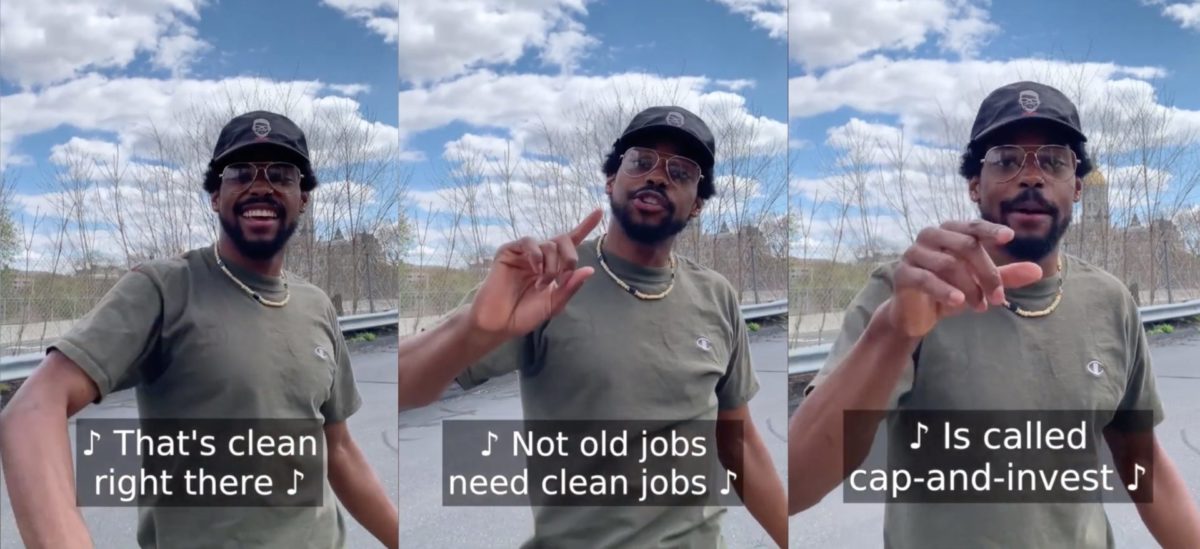
By Cynthia Perez
John Manselle-Young, aka TangSauce, is a hip-hop recording artist from the city of Hartford, Connecticut, who is helping to educate the public on the importance of clean, accessible, and equitable transportation through his love for music. A listen through his discography will quickly illustrate his personal life experiences growing up in Hartford, his aspirations, and how these lived experiences have influenced his perspective on social justice issues affecting his hometown.
While his previous songs have touched on topics such as gentrification and Black empowerment, his rap single “That’s Green Right There, That’s Clean Right There” focuses on the harms of pollution caused by the transportation sector, even touching on the East Coast’s developing Transportation and Climate Initiative (TCI) policy. The reach of this single has allowed Manselle-Young to share with listeners the opportunities of TCI’s cap-and-invest policy in an engaging manner, which previously has been considered notoriously challenging to explain in simple, accessible language. It has been an effective tool for outreach and raising awareness of the TCI, as the video has garnered a lot of online attention.
TCI is a collaboration of 12 states developing a program intended to limit and reduce greenhouse gas pollution from the transportation sector and invest in a low-carbon transportation system. Anthony Cherolis, a local community activist and the Transport Hartford Coordinator with the Center for Latino Progress (the Center), describes the policy as a “clear path to collectively reduce emissions while still protecting mobility options and ensuring quality of life for community members.”
More than 30 percent of Hartford’s population lacks access to a car—despite 65 percent of residents working outside of the city, requiring some other form of transportation to get to their jobs. For this reason, a policy like TCI is important to help expand accessible, reliable, and affordable transportation options available to community members. Likewise, the policy intends to reduce the detrimental health impacts of climate change—including immediate impacts of vehicle air pollution, such as asthma and other respiratory ailments—on low-income populations in places like Hartford.
Efforts to advance the cap-and-invest policy in the region are still going strong despite the global pandemic, and the Center has changed the way it communicates with community members. The shift to digital platforms, as well as a desire to find ways to support out-of-work artists, inspired Cherolis to take a creative approach to keep Hartford and Connecticut residents engaged with the TCI cap-and-invest proposal. Before the pandemic, the organization engaged with the public through networking events—such as hosting dinners, workshops, discussions, and more. With the sudden halt in these activities, Cherolis quickly sought—and received—additional grant funding to support local artists who could create artwork highlighting TCI and other important issues, which could be shared virtually.
Cherolis began contacting artists from around the city and metro region, and found it easy to connect with those who already expressed interest in issues pertaining to civic engagement, social justice, and the environment. The artists supported by the Center’s creative project had artistic freedom, allowing for a wide variety of topics to be addressed, with some explicitly addressing cap-and-invest policy and breaking down what exactly equitable transportation policy is all about. This proved to be a great way to support local artists while simultaneously communicating and educating digitally, enabling the community to connect with the issue via an approachable and relatable medium—whether it’s rap, song, spoken word, educational video, or other form of art. The approach also reached new audiences with these important messages.
The Center for Latino Progress is a member of the Our Transportation Future (OTF) coalition of organizations working on TCI, which recently shared Tang Sauce’s piece and others on its Youtube channel. Other artists include Fernandito Ferrer (“We Need to Reinvent”), Joey Batts (“Make It Cleaner”), and Klokwize (“Tryin’ to see through the air pollution”). The works of more artists will be posted on the channel soon.
“We all got creative in some way during this pandemic,” says Cherolis. “In our outreach and communications about TCI, we were excited to have the opportunity to pay local artists, rappers, singer-songwriters, and activists to put their skills to work. Many of these artists lost not just one but two incomes due to the pandemic restrictions. Several of the works that were created as part of this project are so good that I get chills.”
“This innovative and creative approach to engaging with the public on climate change is exciting because it has the potential to bring our core issues to even more people,” says Kathryn Zyla, Energy Foundation’s Program Director, Northeast Policy. “Throughout history, art and music has always been a way for advocacy to reach people’s hearts and change minds. We appreciate CPL and all of the artists who contributed to this important project.”
Paying attention and responding to what works for online organizing has been shaping the Center’s next steps with the TCI policy. Online meetings have allowed for convenings with much larger audiences, including participants from out of the area—even out of state. However, community organizers have noted that the online work, while reaching a broader audience, also has brought a loss in diversity of meeting attendees. It has become more challenging to ensure that the meeting audiences are local and that they closely reflect local resident demographics.
Cherolis says, however, that Hartford community members are becoming more comfortable with online meetings, and with intentional outreach, attendee diversity is improving—which is essential to ensuring a policy that works for everyone. Cherolis says, “One thing we can do for online meetings is include demographic questions in the registration form. If we find that a meeting is falling short with a demographic, we can put extra time into focused outreach to close the gap.”
Another best practice from the Transport Hartford events is to ensure that speakers and panelists reflect the diversity of the audience one is trying to reach.
That, and the creative ways artists are sharing their perspectives on climate change.
___________
 Story author Cynthia Perez was an Energy Foundation 2020 summer intern.
Story author Cynthia Perez was an Energy Foundation 2020 summer intern.

